Source: technologyreview.com
Published: May 10, 2016
By Ryan Bradley
Startup Hyperloop Technologies has started shooting magnetically levitated capsules along a track in Las Vegas to show off a radical idea for the future of freight and mass transit.
The tube is out back, 11 feet in diameter, 60 feet long, the unfinished end spiraling into wide ribbons of steel—like a gigantic Pillsbury dough container with its seams gaping open. Behind the tube is a big blue tent known as the robot school, where autonomous welders wheel or crawl along, making the tubes airtight. The goal is to put tracks and electromagnets inside the tube and vacuum the air out. Ultimately, capsules will scream through the center of such a tube at 700 miles per hour on a cushion of air—a way to get from A to B faster and more efficiently than planes or trains. The first public tests of this concept, albeit on an open-air track, will take place in North Las Vegas this week (you can read about the results of that test here). They’re aiming to hit 400 miles per hour.
Entrepreneur Elon Musk introduced the world to the concept of a giant vacuum-tube transportation system, the Hyperloop, two and a half years ago. The basic idea is to build a partially evacuated tube, inside which capsules would float on a layer of air, pulling themselves along with a fan and getting extra propulsion from electromagnets in the tube’s walls. Musk talked of trips from San Francisco to Los Angeles in 35 minutes, with off ramps at each end loading and unloading pods with 28 seats every two minutes. Although the design was ambitious to the point of being outlandish, none of its components were fundamentally unproven, something often overlooked. But Musk was too busy revolutionizing the space industry (as CEO of his company SpaceX), the automotive industry (as CEO of his other company, Tesla Motors), and the energy industry (as chairman of his other company, SolarCity), to devote any time to the Hyperloop. He released a 58-page outline of his implausible idea and left it to someone else to finish it off.
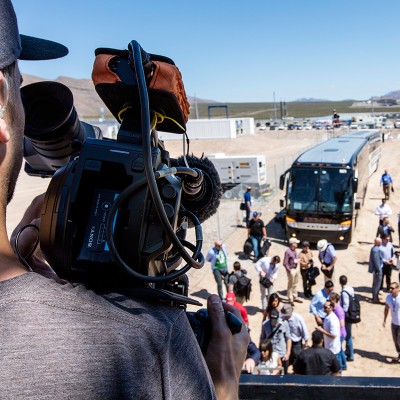
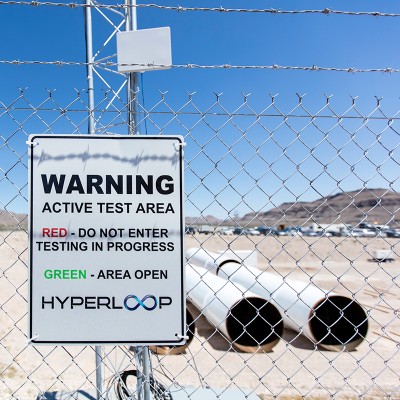
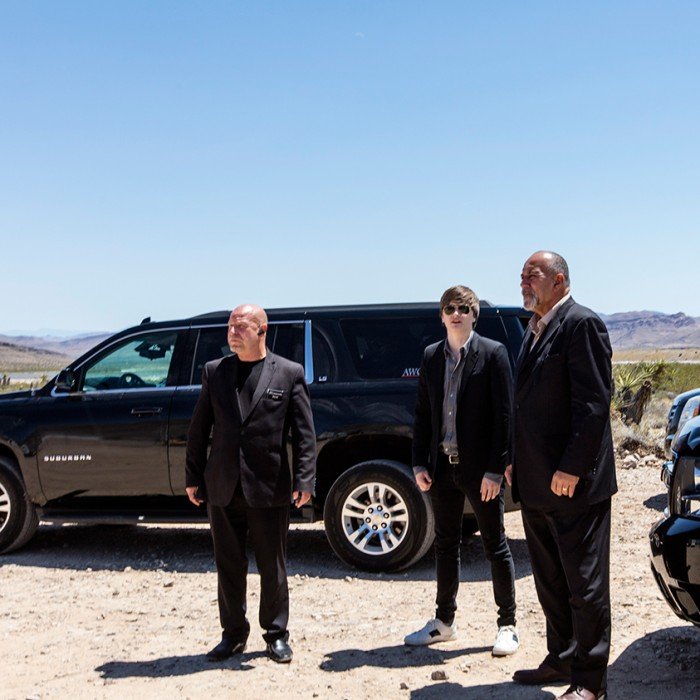

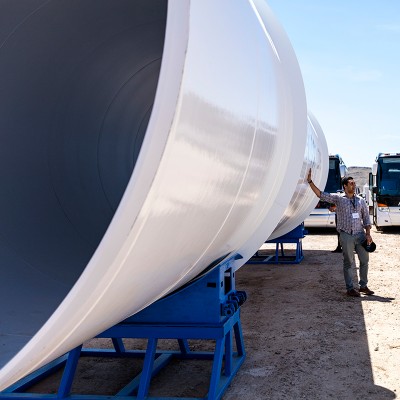
Investors, journalists, and employees explore Hyperloop One’s test site in North Las Vegas.
In a former ice factory by the paved-over Los Angeles River, a startup company called Hyperloop Technologies is trying, using $100 million from optimistic venture capitalists. Musk’s improbable and incomplete design and his unlikely plan to get it built are suddenly looking less unbelievable—maybe even conceivable. Maybe. “The thing about Hyperloop is that it does not exist until it actually exists,” Josh Giegel, vice president of design and analysis at Hyperloop Tech, tells me before we step into the backyard to look at the various elements of the Hyperloop that do exist. There’s the tube, the robots, a length of track, and various pieces of the electromagnetic propulsion system. A couple of hundred miles away, 2,000 feet of track in the Nevada desert is being readied for a public test of the track and electromagnetic propulsion system.
Giegel left the space tourism company Virgin Galactic to join Hyperloop Tech as its first employee a year and a half ago. At the time the company was based in a garage in the Los Feliz neighborhood of Los Angeles. The garage was owned by Hyperloop Tech’s cofounder, a fellow stupendous in facial hair, engineering chops, and name: Brogan BamBrogan. He’d worked with Giegel—and for Musk—at SpaceX, a company that sent a craft into orbit to dock with the International Space Station just five years after incorporating. In the Hyperloop they’d found something still more audacious that has drawn even more skepticism and snickering. But here I was staring at giant tubes and robots and powerful magnets and being told that within weeks the world would see the core of the crazy thing tested in public.
Floating steel
The fact that two-year-old Hyperloop Tech has already grown from a handful of engineers in a garage to 140 people across three acres of old industrial buildings near downtown Los Angeles, plus a patch of desert in North Las Vegas, seems to indicate something about the West Coast tech industry in 2016. Perhaps that it’s too easy to raise tremendous cash reserves for technological larks. Or perhaps the power and promise of an entirely new form of transportation.
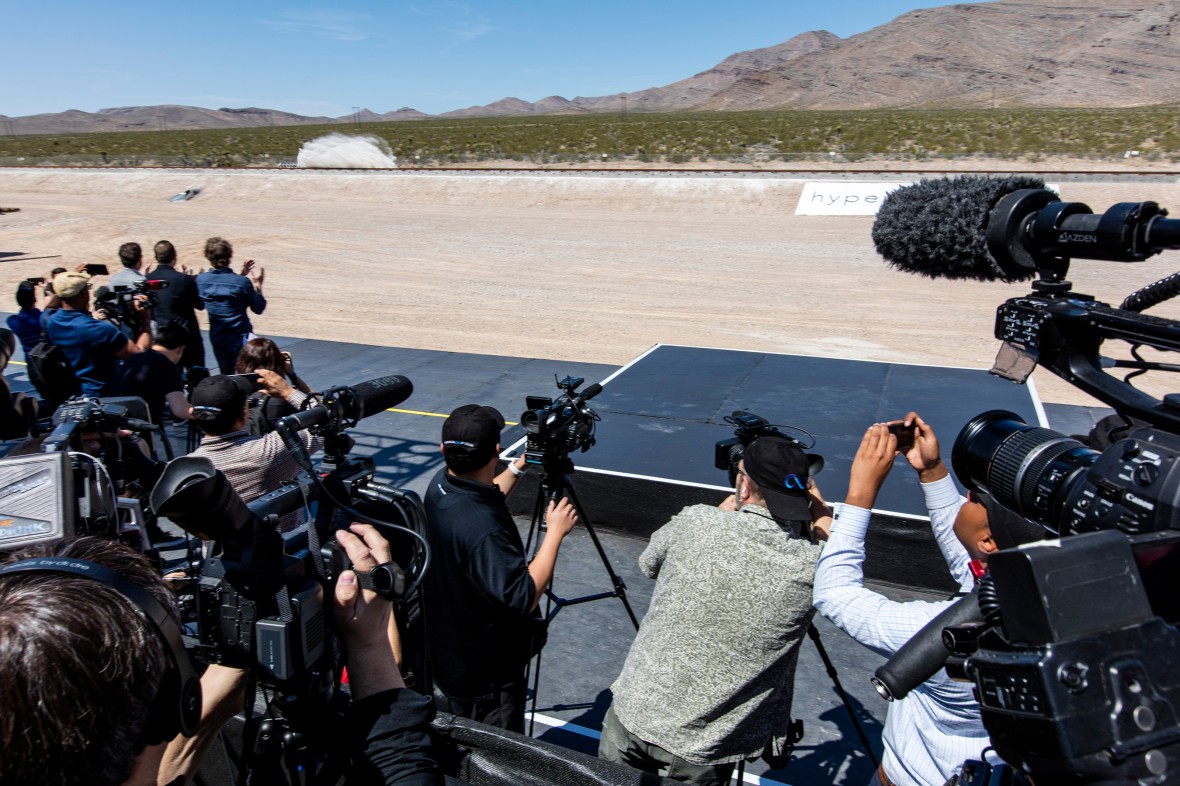
A metal sled streaked along a 2,000-foot track in a test of Hyperloop One’s electromagnetic propulsion system.
Either way, Hyperloop Tech’s growth is impressive (and puts it far ahead of a competitor, Hyperloop Transportation Technologies, which is funded by donations). A tour of Hyperloop Tech’s offices offers both the aesthetic notes of a fast-growing startup (exposed brick, stand-up desks, whiteboards, huddles of engineers) and the delights of an inventor’s workshop. Beyond the steel tubes and welding robots, there’s a wind tunnel, a huge pressurized chamber called the levitation rig, and an even bigger vacuum tube (appropriately dubbed the Big Tube) for testing the full set of Hyperloop components. I also see a block of electromagnets float a large, flat steel square a foot or so in the air. It hovers there stiffly, so stiffly that even when I press down on it very hard, it does not budge. This was a demonstration of the Hyperloop’s shock absorption system. Possibly. Everything is being continuously built and tested and torn apart and put back together again. It’s a methodology lifted from Musk, who at SpaceX set out to apply principles from software engineering, like continuous iteration and exploration, to the kind of massive hardware usually built slowly and surely, without any backtracking. “We build fast, adapt fast, and get a lot more data rather than wait and wait until one final build, which may or may not work,” Giegel tells me, beaming.
We move from the backyard, where the tubes were, to a room adjacent to the banks of monitors, exposed brick, and engineers: the power electronics lab. It’s literally humming with various tests running in every corner, on generators, switch boxes, and hulking pressurized chambers. Hyperloop Tech engineers are tweaking Musk’s original plan, which imagined solar cells atop the tubes feeding energy to acceleration points every 40 or 50 miles where pods would get an extra magnetic shove. In between, pods could coast without much slowing down thanks to their air cushion and low pressure in the tube reducing friction (a well-designed braking system could reclaim energy when it was time to slow down). But counting on solar energy to deliver the sudden bursts of power to the acceleration magnets doesn’t look practical for all places or weather conditions. And Hyperloop Tech claims to be in talks with governments and businesses “all around the world.” The company is designing the Hyperloop to use any power source.
Although the design was ambitious to the point of being outlandish, none of its components were fundamentally unproven.
Rob Lloyd, Hyperloop Tech’s CEO, pulls out his phone and shows me a series of photographs: a white rail, open to the air, running into the distance across a flat sandy expanse of Nevada desert. “The first test was”—he checks his watch—“a few hours ago. This morning.” During my visit it’s an early afternoon in the middle of April. He says that within a few weeks he expects to be running the test sled down the test track at speeds of more than 400 miles per hour. By the end of the year, they’d break 700 miles per hour.
“We’re working in a time frame that shocks people, because we have to,” Lloyd continues. The Hyperloop does not exist until it exists, and politicians won’t believe in it either until it exists, he says. Lloyd went state to state looking for somewhere with a loose enough regulatory system that a test site could be built more or less immediately. Although many states boasted the necessary “regions of great flatness and straightness,” as Lloyd puts it, all clammed up at the thought of a big, heavy, fast test track. All except reliably business-friendly and regulation-free Nevada. “People we got here hate waiting to do things,” Giegel says. So North Las Vegas was it. Lloyd says he is closing in on a deal overseas for a larger test site that could turn into a full-scale production system. As well as much more track, it would have the capacity to try out hauling, loading, and unloading shipping containers, and integrating with existing transportation facilities, such as docks.
Indeed, although Musk emphasized transporting people, Hyperloop Tech’s vision is broader. Lloyd tells me to think of it as a network of tubes, exchange points, and off-ramps that can transport all kinds of things. It sounds a lot like the Internet, and not by accident. Lloyd joined Hyperloop Tech after retiring as president of networking equipment company Cisco, where he spent decades building Internet infrastructure through deals brokered with governments and businesses worldwide. He was convinced to join Hyperloop Tech by the company’s cofounder and chairman, investor Shervin Pishevar, most famous for making a large bet on Uber.
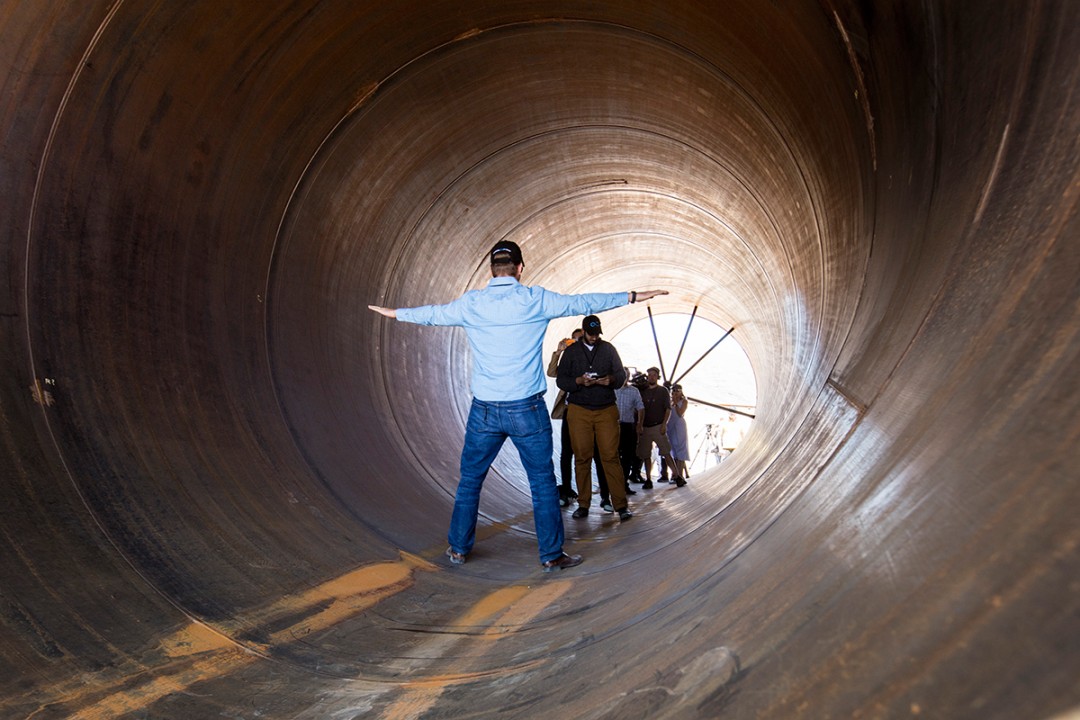
Visitors pose inside a tube designed to house pods carrying cargo or passengers at high speeds.
“Transportation is the new broadband,” says Pishevar. He sees Uber and Hyperloop as complementary. “You are taking atoms and bits and, for the first time in history, smashing them together,” he says. “I can take my phone out and move a car in Beijing if I wanted to. Hyperloop will do the same, but between cities.”
Crazy talk
There are still plenty of reasons to believe the Hyperloop will not exist. “It gives me pause to think that otherwise intelligent people are buying into this kind of utopian vision,” says Jose Gomez-Ibanez, a professor of urban planning and public policy at Harvard. “I don’t understand where they think they can get their savings—they’re up against the airlines, and airlines don’t need to install hundreds of miles of track.” Giegel counters that airlines expend a tremendous amount of energy getting up to 30,000 feet and don’t recapture any of it on the way back down. The low pressure inside Hyperloop Tech’s tubes aims to replicate the atmospheric drag at about 160,000 feet. The company calculates that the magnetic boosts required every 40 miles or so will allow a Hyperloop to be more efficient than rail can be at very high speeds.
“We’re working in a time frame that shocks people, because we have to.”
Another (fair) criticism is that the upfront installation costs will be outrageously expensive, even compared with rail, and especially compared with Internet infrastructure, despite Hyperloop Tech’s favored analogy. “Laying optic fiber is not really pricey,” says Genevieve Giuliano, a transportation professor at the University of Southern California. “Laying Hyperloop tube is going to be pricey.” But she and the other economists and transportation experts I spoke to perked up when I explained Hyperloop Tech’s interest in freight. “The concept is right,” says Giuliano. Freight rail in the U.S. is already quite profitable and efficient (Warren Buffett invests heavily in it). But a high-speed freight backbone—broadband for goods—linking major population centers could make economic sense, she says.
How much economic sense is hard to know. Large transit projects must balance three buckets of money, says John Macomber, who lectures on urbanism and real estate at Harvard Business School: construction, operations, and value creation. The first two are not too difficult to estimate. The third is incredibly difficult. Calculating the economic payoff of a working Hyperloop is very hard to do, especially ahead of raising the piles and piles of cash necessary to build it. This is why massive transportation infrastructure projects have usually been undertaken or supported by governments, not private industry, despite the fact that private industry can reap huge benefits. Nearly every shipping company in the world benefits from the U.S. interstate system, for example. Their containers leave ports on trucks that roll along roads built with taxpayer dollars. Hyperloop Tech’s leaders aren’t against the idea of public funding. But they argue that in an era where consumers and companies such as Amazon expect goods to move faster than ever, a Hyperloop could be subsidized by businesses that stand to benefit. Then when the infrastructure is built and the kinks are worked out, people could travel on the Hyperloop, too.
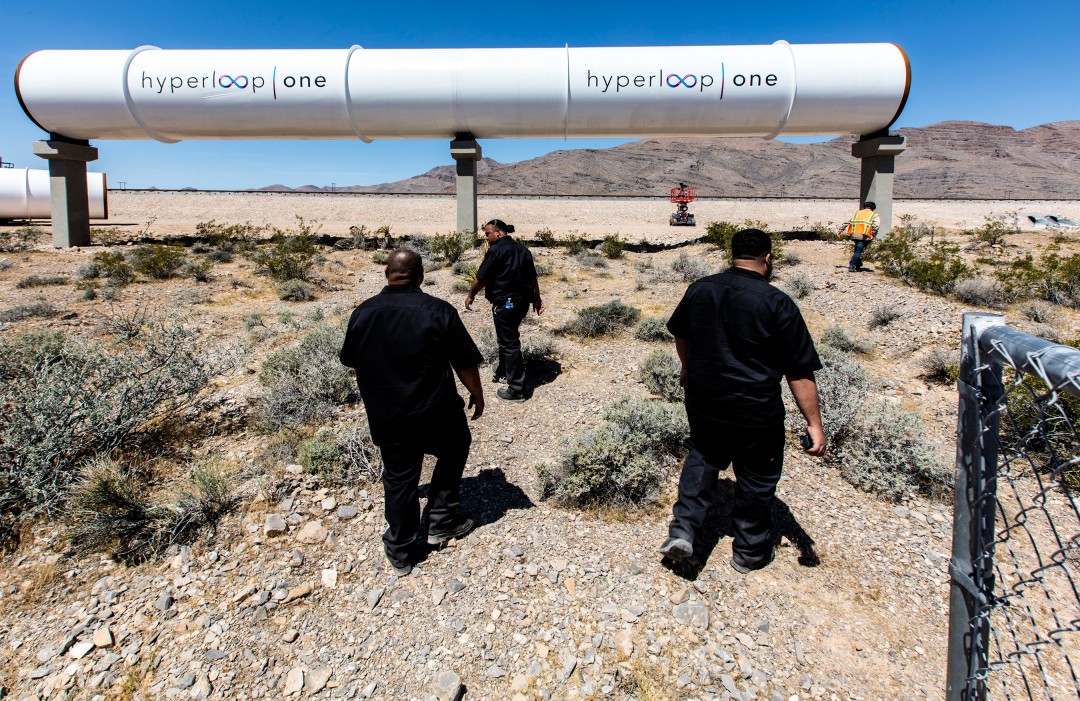
A section of tube at Hyperloop One’s test site in North Las Vegas.
At the end of my afternoon at Hyperloop Tech, Giegel and I stare at a big screen displaying a grand image of a Hyperloop system integrated with a container port, the tubes moving underneath and alongside a ship’s berth. Then we look at another rendering that feels slightly closer to reality: a map of a roughly 90-mile-long Hyperloop connecting Abu Dhabi and Dubai, complete with off-ramps and acceleration points. Finally, we walk back to Giegel’s desk and gaze at the one piece of decor along the exposed brick walls: vintage posters from the golden age of rail travel, when train engines looked like gleaming silver bullets, visions of a spectacular future that had already arrived.
Giegel mentions how early presentations about the Hyperloop included schematics of the first pneumatic railway. “Do you know how long ago that was built?” he asks. I disappoint him with my answer, because I know all about the London and Croydon Railway, which had run 7.5 miles and achieved, in September 1845, a top speed of 70 miles per hour. The pneumatic tube was underneath the cart, between the rails, and a series of engines pumped air out ahead of the train, creating a vacuum that drew it forward. And I know that it closed just two years after it opened, after it was unable to connect seamlessly to traditional rail. Giegel’s face brightens at that cautionary tale. “Yes. Exactly!” That was the point: it failed because it couldn’t integrate into existing systems. It was ahead of its time, but also outside of its time. Hyperloop Tech has to be wary of falling into the same trap.
As Giegel says, the Hyperloop does not exist until it exists.
